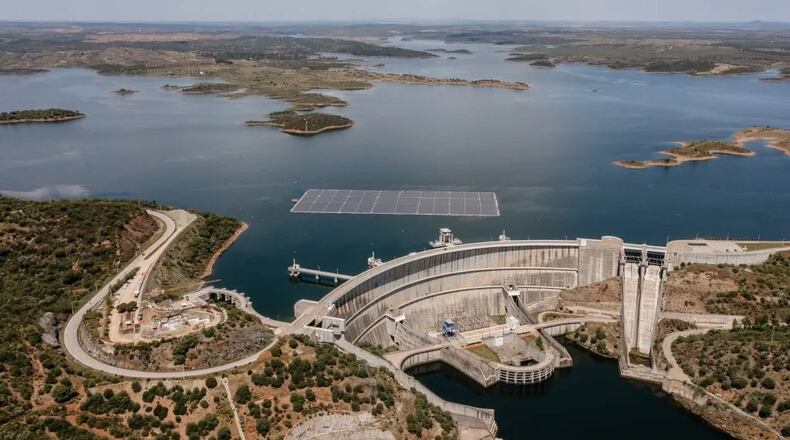The sun’s power is virtually infinite.
But opportunities to collect and make use of it are not.
As demand for renewable energy increases, so does the need for places to generate it.
That has set off a global scramble for real estate on which to build the green energy infrastructure the world desperately needs to avert a climate catastrophe. This is especially true for large solar arrays, which take up vast amounts of acreage.
Over the last few years, a technological evolution has resulted in solar farms that take up no land at all.
The most recent major example went into operation in July – an array of 12,000 solar panels 100 miles southwest of Lisbon bobbing atop the reservoir of Portugal’s Alqueva dam.
With a span of four soccer fields and a peak capacity of five megawatts, the Alqueva Floating Solar Power Plant, built by Portugal’s main public utility EDP, is the largest floating solar farm in Europe. It generates enough electricity to meet the needs of more than 30 percent of the region’s population.
It’s part of a rising tide of floating solar — or “floatovoltaic” — power plants that are proving the renewable revolution need not stop at land’s end.
Over the past decade, the growth of floating solar has been astoundingly rapid, both at Alqueva and beyond.
The sheer size of the Alqueva project is remarkable given how young the technology is.
The first commercial floating solar array was built in 2008 and mounted on an irrigation pond at the Far Niente Winery in Oakville, Calif. A lot has changed since then, and the world of commercial floating solar has ballooned from a pontoon-mounted 175-kilowatt Napa Valley novelty to a burgeoning global industry.
Why make it float?
In 2015, when EDP first experimented with floating solar with a 220-kilowatt pilot project in Northern Portugal, global floating solar generating capacity stood at roughly 68 megawatts.
Today, total capacity is about 5,000 megawatts — a 73-fold increase.
The driving force behind this meteoric rise stems from improvements in solar technology itself.
Between 2009 and 2021, the cost of electricity from photovoltaic solar fell by over 90 percent. Over the same period, worldwide solar generating capacity has increased by a factor of 20, from 40 gigawatts to over 840 gigawatts, as panels have cropped up across rooftops, deserts, farmland and fields.
Today, most solar generation occurs on solid ground.
So, why bother making it float?
Among major energy sources, solar has a high land-intensity, with ground-mounted photovoltaic systems requiring 200 square feet per megawatt hour of capacity, on average.
As demand for solar generation increases, competing interests for that acreage, from agriculture to development to preservation, are among the biggest challenges the industry faces in its efforts to expand.
‘Untapped potential’
There are few tracts of real estate on Earth more valuable than Napa Valley soil, which helps explain why a California winery became the site of the world’s first floating solar farm.
Floating panels at the Far Niente Winery meant more vines and more wine.
The floating array saved the winery three-quarters of an acre of land, allowing it to produce $150,000 of additional Cabernet annually.
As floating arrays have gotten cheaper, they’ve proven useful — and cost-effective.
“If you know anything about Florida, and especially south Florida, you know that we have retention ponds and bodies of water just throughout our entire peninsula,” said Stetson Tchividjian, director of business development at D3 Solar.
“Where land is either very expensive or very scarce, why not utilize a lot of these bodies of water?”
Founded in 2013, Florida-based D3 Solar was one of the first developers in the United States to specialize in floating solar. D3 has built floating rigs for the U.S. Army, Miami International Airport, and even a multicolored array for Universal Studios that bears the Comcast logo.
Though sunny and tropical Southern Florida is among the regions best suited for floating solar, opportunities for expansion don’t end there.
“There is still so much untapped potential when we look at available water bodies globally,” said Molly Cox, project manager on the Solar Independent Engineering team at DNV, an Oslo-based risk-assessment firm.
In 2018, the National Renewable Energy Laboratory identified 24,419 man-made bodies of water in the U.S. alone as suitable for floating solar development. If those lakes, ponds and reservoirs — representing just 12 percent of total man-made water area — were utilized, their potential solar generation could reach 10 percent of the United States.
And utilizing even small tracts of water can yield outsized benefits.
But the benefits do come at a cost.
Sky is the limit
Floating solar systems are, on average, 30 percent more expensive than ground-mounted solar.
Virtually all of that extra difference comes from the increased structure costs, which make up a share of total costs three times larger than in ground-mounted solar.
The costs of floating solar arrays aren’t just monetary.
Most are mounted on plastic-intensive rigs – but that may soon change.
The Alqueva project is the world’s first to use a new type of panel mount made of recycled plastic and cork.
These hybrid floaters are 15 percent lighter than their pure-plastic predecessors and less carbon-intensive, reducing the total carbon footprint of floating arrays by 30 percent.
The utility in Portugal is set to expand the Alqueva park to 70 megawatts of capacity, and the company is gearing up to invest millions in Southeast Asia.
Meanwhile, records continue to be broken nearly as soon as they’re set.
The tides of floating solar have risen faster and higher nowhere more so than in Asia, which accounts for some 70 percent of global capacity installed over the last five years.
Last November, when a 145,000-panel, 45-megawatt farm came online in Thailand, it was the world’s largest. Three months later, China’s Dezhou Dingzhuang unveiled a whopping 320 megawatts of capacity.
That project’s record won’t last long, either: Next year, a 600-megawatt farm is slated to come online in India.
How long that project will keep its title is uncertain.
With solar, the sky — and water — is the limit.
Eric Krebs writes for Reasons To Be Cheerful, a nonprofit editorial project that strives to be a tonic for tumultuous times.
About the Solutions Journalism Network
This story is republished through our partners at the Solutions Journalism Network, a nonprofit organization dedicated to rigorous reporting about social issues.
About the Author
Keep Reading
The Latest
Featured



